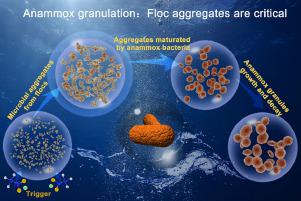Water Research ( IF 11.4 ) Pub Date : 2021-01-04 , DOI: 10.1016/j.watres.2021.116807 Jialin Li , Yongzhen Peng , Qiong Zhang , Xiyao Li , Shenhua Yang , Shuai Li , Liang Zhang

|
Rapid enrichment of anaerobic ammonia oxidation bacteria (AnAOB) is highly associated with the granulation process; however, the interactive mechanism remains unclear, especially for the initial granulation process. A single-stage partial nitritation-anammox (PN/A) bioreactor combined with granular/floc sludge was operated for 400 days. During the experimental period, the nitrogen removal rate increased from 0.60 to 1.21 kg N m−3 d−1, and the nitrogen removal capability improved primarily during a transition period (days 200–250), which was accompanied by a particle size increase and AnAOB proliferation (4.9 ± 1.7 days). Moreover, as observed by the biomass physio-morphology, the size distribution, and the microbial community shift, small flocs (< 200 μm) aggregated due to the addition of excess sodium acetate. The emerging floc aggregates represented an early form of granules, providing the initial biological carrier and necessary anaerobic microenvironment for the growth of attached AnAOB, resulting in a high AnAOB growth-rate. These results are the first direct evidence that floc aggregates are essential to AnAOB enrichment, and that they can be affected by operational conditions. This study provides an in-depth understanding of the link between floc aggregations and AnAOB enrichment and broadens the feasibility of optimizing PN/A applications.
中文翻译:

在单阶段部分硝化-厌氧氨氧化过程中,快速富集与絮凝物聚集体相关的厌氧氨氧化细菌:提供初始载体和厌氧微环境
厌氧氨氧化细菌(AnAOB)的快速富集与制粒过程密切相关。但是,相互作用机制仍然不清楚,尤其是对于最初的制粒过程。单级部分硝化-厌氧氨(PN / A)生物反应器与颗粒/絮凝污泥组合运行400天。在实验期间,脱氮率从0.60 kg增加到1.21 kg N m - 3 d - 1,并且除氮能力主要在过渡期间(200-250天)提高,同时伴随着粒径增加和AnAOB增殖(4.9±1.7天)。此外,通过生物量的生理形态,大小分布和微生物群落迁移观察到,由于添加了过量的乙酸钠,小絮凝物(<200μm)聚集。新兴的絮凝物聚集体代表了颗粒的早期形式,为附着的AnAOB的生长提供了初始的生物载体和必要的厌氧微环境,从而导致了较高的AnAOB增长率。这些结果是絮凝物聚集对于AnAOB富集必不可少的第一个直接证据,并且它们可能会受到操作条件的影响。











































 京公网安备 11010802027423号
京公网安备 11010802027423号